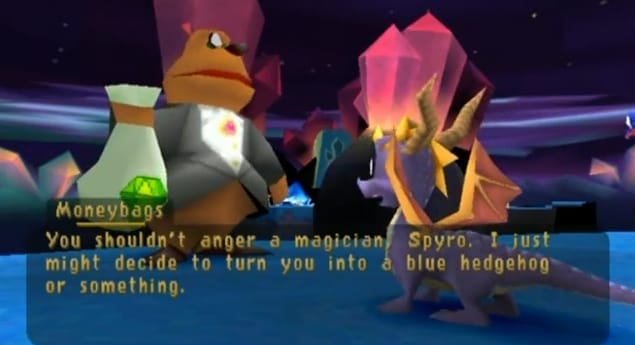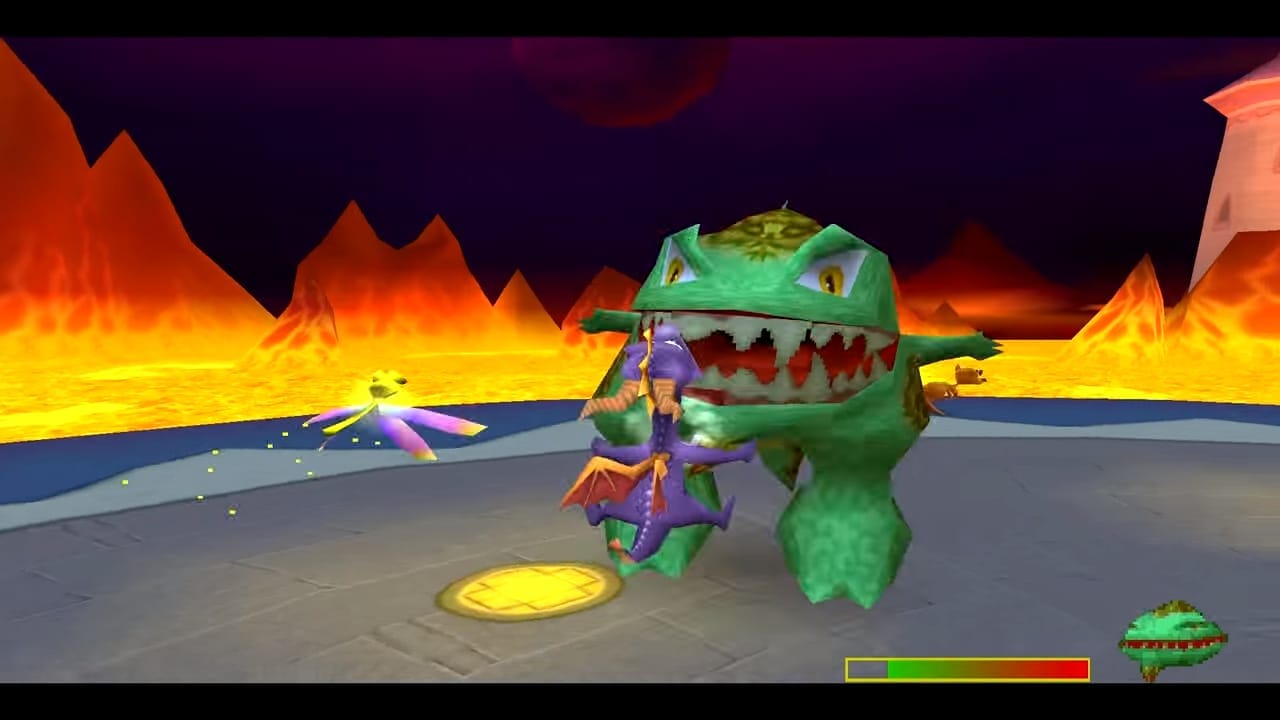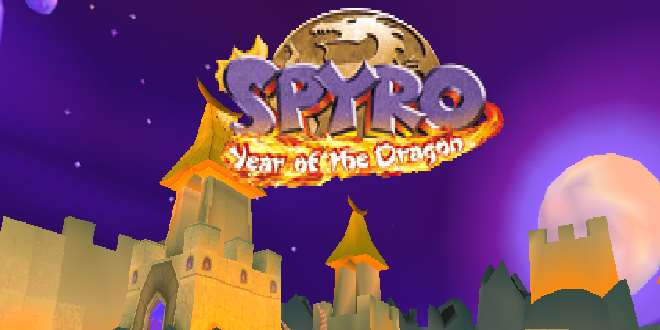I'm not sure if this is an original observation, but I've discovered something in my time going back to Spyro: Year of the Dragon. Insomniac's purple mascot is the 3D equivalent of Sonic the Hedgehog. Think about it. Both series tote momentum based gameplay where a player can rush through levels by mastering movement mechanics. Both series have secrets and collectibles in tough to reach spaces that encourage exploration and clash with the focus on speed. Perhaps most damning for this review, both series are eventually invaded by countless animal friends that don't bring much to the table. Gliding around and torching sheep as Spyro feels as fresh as it did back in the 90s, but Year of the Dragon's focus on gameplay variety over focused platforming dashes its chances to be remembered as a classic on its own merits.
Year of the Dragon finds Spyro traveling to a new realm to chase after The Sorceress and rescue the clutch of dragon eggs she has stolen from his realm. Along the way, Spyro meets up with five new friends, including Shiela the Kangaroo and a laser gun toting monkey named Agent 9. Hunter the Cheetah from Ripto's Rage is also along for the ride, and the team warps from world to world in order to recapture the eggs and overturn the rule of The Sorceress. Nothing out of the ordinary for the series, and the dragon eggs are a better choice for a collectible than Ripto's assortment of talismans and orbs.

A typical level in Year of the Dragon consists of warping in, talking to an NPC, navigating down a linear path to the exit, and then getting to the meat of the levels afterward. There is platforming to be done, but exploring the worlds just doesn't feel very satisfying. Spyro doesn't lose any abilities from the last game, but he doesn't really gain any here either, and it feels like Insomniac were going out of their way to come up with ways to get the player to do anything but charge around as the game's title character. There just aren't that many tucked away areas in the main levels, as you're instead working to unlock hidden portals that will take you to one of the game's many many minigame challenges.
Beyond each level's first egg, the rest are collected through participating in a variety of minigames. These include sliding around haphazardly on ice fields trying to fend off attackers, battling a robotic shark, and swimming on a rocket powered manta ray. There is even a collection of skateboarding sections, as it was the year 2000 and every video game released that year had a skateboarding section. The sheer number of these activities is impressive in its own right, but none of them control particularly well compared to the main action. The fact that most of them have strict time limits and a one life limit means that completing them requires instant mastery and frustrating repetition. The constant tutorials and trial and error that these minigames provide made me dread having to complete them, and you need to clear a good chunk of them to unlock the final boss battle.
Of course, a handful of the game's levels can also be categorized in the same way, being complete departures from the basic gameplay of the series. Each overworld has one level dedicated to a side character, and none of them are developed enough to warrant this much attention. Shiela the Kangaroo's jumping gives her verticality, but it means that you'll be flying through the air and losing control often. Sgt Byrd and Agent 9's shooter-based gameplay (complete with a then-novel first person camera) reminds me of how bad the genre was on consoles until Halo released the following year. Bentley the Yeti's lumbering makes his moments slow and plodding, although bashing things with his club is admittedly dumb fun. With a bit more effort and a few more abilities, any of these characters would be fine to inhabit, but their levels feel like half-finished additions to an already stuffed package.

Between the various playable characters, vehicles, and other alternate play methods that you'll be using throughout the adventure, Year of the Dragon has a lot of tutorials to dish out, which means that you'll also be dealing with a whole host of NPCs chatting your ear off at every turn. The voice acting ranges from acceptable performances to accents that wouldn't sound out of place on Adult Swim parody programming. None of it seems vital or useful, and there isn't really a great effort at world-building. Each level has a theme and each character basically only has one thing to say, ensuring that these forced exchanges do nothing but kill the pacing whenever they pop up.
Graphically, the game still looks mighty impressive for a PlayStation game, and the main characters all look appropriately cartoony. Fodder enemies and other models are less well-designed, and there are some known issues with slowdown in the PS1 Classics version of the game I played. Even more impressive is the game's soundtrack, which is still as catchy and out of the ordinary as ever. The dreamlike percussion composed by Stewart Copeland of The Police fame fits Spyro's world perfectly, and I wish every game had backing tunes that were so unique and thematic.
Discovering how little Spyro the Dragon is in Year of the Dragon was a real shame, because controlling Spyro and nailing a line of enemies with a charge is still extremely satisfying. The fleeting moments of platforming challenge in the game are as great as anything Insomniac created for the franchise. Nailing a far off glide to a hidden area or chasing the egg thieves while never losing momentum—that really is what the Spyro games are about. There is some fun to be had, but no amount of great platforming is worth slogging through the endless distractions and lousy controls that define Spyro's third PlayStation adventure.
Spyro: Year of the Dragon was reviewed on PlayStation 3 via the PS1 Classics program with a copy purchased by the reviewer. The game was selected for review by a $50 patron via our Patreon campaign.
Review Summary
Time has not been kind to this PS1 standout, as a focus on minigames and alternate characters force the purple dragon out of his own game.
(Review Policy)Have a tip, or want to point out something we missed? Leave a Comment or e-mail us at tips@techraptor.net













